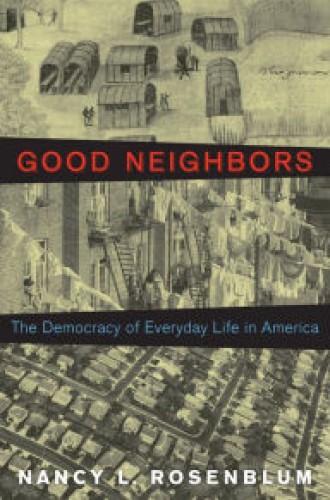In Luke’s Gospel, Jesus invites those gathered around him to think about the two greatest commandments: loving God and loving the neighbor. A nearby lawyer desires specification: “And who is my neighbor?”
Recently, a presidential candidate called for monitoring Muslim neighborhoods. The airwaves filled with analytical chatter. “Is this what we’ve come to?” was met with the frank “This is what we’ve come to.” Beneath this rhetoric is the biblical lawyer’s question: Who are our neighbors and how are we to treat them?
Jesus answers the lawyer by telling him a story. As if heeding Jesus’ example, Brian Doyle and Nancy L. Rosenblum use stories to invite readers to reflect on what it means to be a neighbor.
Doyle’s novel invites us into a very small world—an apartment building in the heart of Wrigleyville on the north side of Chicago. This is an autobiographical story of a young college graduate out in the world for the first time.
Doyle’s world is idyllic: neighbors of diverse heritage look out for one another. Against the backdrop of the “greed is good” 1980s, a focus group of struggling humanity figures out life together between the streets of Addison and Belmont, through the eyes of the author “dreaming [himself] into being a man.” Playing basketball with street gangs, hanging out as (unbeknownst to him) the only straight man in a gay bar, watching the White Sox at Comiskey Park with first-time immigrants from neighboring apartments, buying empanadas, and striking up conversation with a bus driver on the early morning shift (“the Sound Asleep Bus”), Doyle makes the ordinary extraordinary, which is his charm. The storyteller’s days are full of conversations with the building handyman, a dog, and himself as he develops his adult self.
Read our latest issue or browse back issues.
The characters that occupy each apartment walk the line between reality and fantasy. Doyle’s typical run-on prose wanders through their fantastical lives as they pool resources and devise schemes to save their debt-ridden landlady, watch the stars from the rooftop together, or contend with a changing neighborhood demographic. In Doyle’s world, the answer to “who is my neighbor” is resolved through proximity: your neighbors are all around you.
And not just humans, but all life that is in proximity. This last point is driven home through the story’s animals, who take on personalities that go beyond ordinary fauna. (The alley rats are “arrogant as aldermen.”) This anthropomorphism is seen most keenly in Edward, a canine whose behavior is so humanoid and whose knowledge of Abraham Lincoln so vast that he blurs the line between person and pet.
Even the city as a whole and blue-green Lake Michigan, which Doyle affectionately labels “a sea,” are neighbors. Neighborliness means enmeshing your life together with all of life. Survival is not for the fittest but rather is forged out of the fineness of your community, for however long you’re there.
Rosenblum, who teaches ethics in government at Harvard, has a decidedly less idyllic take on neighbors and neighborliness. She invites readers into a much larger world that, while confined to the American context, crosses multiple eras, using rich literature as its lens. Her aim is not to engage readers with a single story, but with many stories. Her political theory of the neighbor takes on flesh and bone through texts as varied as Robert Frost’s “Mending Wall,” Willa Cather’s My Ántonia, and informal personal testimony obtained (and given) by Rosenblum herself through the course of her research. Is the idea of “neighbor” a moral category? Is it a matter of civic definition? A simple term used to describe those who make their home in proximity to yours? What makes a good neighbor today?
For Rosenblum, neighbor is not found by mere proximity nor by simple moral or civic understandings, but rather in the idea of what she calls “decent folks.” Neighbor is about behavior. Decent folks are reciprocating, trustworthy, divorced enough from others so as to keep some distance. They allow their neighbor latitude. Most important, though, “decent folks” are seen and acknowledged through day-to-day interactions, not through some other social, political, or organizational lens.
Rosenblum begins her analysis with stories of settlers, the preeminent tale of the American landscape. We are a settler nation, particularly in our collective imagination. Cather’s My Ántonia provides one lens through which we understand neighborliness: it’s about survival—decent folks helping one another on the frontier, irrespective of social standing or background. The level plains make all things level. Cather’s novel also invokes that other seminal tale, the immigrant story, although the relationship between settlers devolves as prejudice and animosity grow. In both settler and immigrant stories, neighbors are leaned on for survival.
This is Doyle’s world, too. Most of the occupants of his three-story apartment building are immigrants, and he too is a settler of sorts in the new, strange land of Chicago. They lean together for survival and mutual enjoyment. Under this definition, they behave as decent folks.
But we are no longer a settler nation. We live in a world of suburbia, and while settler stories give us our ideal of neighbor, the suburban mind-set of fences and privacy has changed our reality. Doyle’s winding prose winds just a little too far into each other’s business to meet the suburban expectation of privacy. What makes Chicago so enrapturing is exactly what Rosenblum notes might be too much to be believed: the dreamlike intimacy of each character with one another and their environment without falling into the paranoia of suburban notions of privacy or mistrust as confidences are broken.
Rosenblum’s research provides a different possible outcome for Doyle’s rosy prose—one where the inhabitant of apartment 4a doesn’t always invite the immigrant in 4b to the White Sox game, but rather sometimes invites increased scrutiny of his activities. When people are actively encouraged to count the neighbor not as “decent folk” but as “suspect,” everyday democracy breaks down. This is the unsentimental underbelly of neighborly interaction in a globalized and partisan world. This is what happens when neighbors view the other with disdain rather than generosity, when the conventions that keep communication open between neighbors—like a simple “how are you today?”—are replaced with a “keep your head down” baseline. This is the danger of leaning too far into privacy and not far enough into reciprocity. Rosenblum’s tour through stories that walk this line both disturb and steel the reader to face reality.
But Rosenblum’s wisdom shines through this unsettling analysis. Her honest reflections on the pull between saying too little and saying too much, between adopting a “live and let live” mentality or speaking out—all of this tension points back to the micro-level for regaining a working definition of the term at hand. Decent folks don’t pretend that this tension isn’t real; they walk the tightrope with their neighbors. As decent folks we don’t know our neighbors (in the sense that most of them aren’t “friends”); yet, we know of them. We are not indifferent to our neighbor’s plight; but we also do not know rightly how much interference is too much. While Doyle’s sentimental veneer can obscure this truth, at heart Doyle and Rosenblum are speaking the same language: small-vicinity relationships of decent folks create democracy, and not the other way around.
Rosenblum invokes Henry David Thoreau to wrap up her analysis of what makes for decent folks, inviting us to consider passages from Walden and Civil Disobedience as examples of how being a good neighbor is more fundamental even than citizenship. Thoreau’s escape to the wilderness was not so much a radical detachment from society as it was a radical reattachment without the constraint of political categories, a return to “settler” status. Indeed, though neighbors were miles away, he still needed them and was, himself, a good neighbor.
Rosenblum’s endpoint is her concern for how politics influences our ideas of neighborliness. A good citizen is not necessarily a good neighbor, or as she puts it, “democracy and the democracy of the everyday life” are not the same. In fact, good democracy is one that allows localized, small-scale, Doyle-sized interactions of decent folks to reign over and against top-down calls for neighbor scrutiny and organization. It allows for us all to dream of a world where neighbor is not a vacuous term for the ones who live around you, but a term for the relationships formed around you that help to create an atmosphere for democracy to happen.
If politics and civic duty cannot compel us to be good neighbors, if calls for increased policing and “see something, say something” won’t fundamentally encourage neighborliness, perhaps stories and intentional reflection on stories can invite us to be “decent folks”—folks who dare to dream of the world as an apartment building full of settlers, folks who hold alive the tension between saying too much and saying too little well, trusting that communal survival is the goal of all decent folks.
After all, we are all someone’s answer to the question, “Who is my neighbor?”







